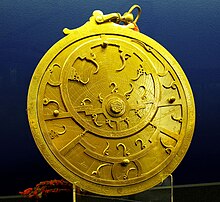
Back علم الفلك في عصر الحضارة الإسلامية Arabic মধ্যযুগীয় ইসলামি বিশ্বে জ্যোতির্বিদ্যা Bengali/Bangla Astronomija u srednjovjekovnom islamu BS Astronomia islàmica medieval Catalan Astronomio en mezepoka Islamo Esperanto Astronomía islámica Spanish اخترشناسی در سدههای میانه اسلامی Persian Astronomie arabe French Astronomía islámica medieval Galician Ilimin taurari a duniyar Islama ta tsakiyar zamani Hausa

Medieval Islamic astronomy comprises the astronomical developments made in the Islamic world, particularly during the Islamic Golden Age (9th–13th centuries), and mostly written in the Arabic language. These developments mostly took place in the Middle East, Central Asia, Al-Andalus, and North Africa, and later in the Far East and India. It closely parallels the genesis of other Islamic sciences in its assimilation of foreign material and the amalgamation of the disparate elements of that material to create a science with Islamic characteristics. These included Greek, Sassanid, and Indian works in particular, which were translated and built upon.
Islamic astronomy played a significant role in the revival of ancient astronomy following the loss of knowledge during the early medieval period, notably with the production of Latin translations of Arabic works during the 12th century.
A significant number of stars in the sky, such as Aldebaran, Altair and Deneb, and astronomical terms such as alidade, azimuth, and nadir, are still referred to by their Arabic names. A large corpus of literature from Islamic astronomy remains today, numbering approximately 10,000 manuscripts scattered throughout the world, many of which have not been read or catalogued. Even so, a reasonably accurate picture of Islamic activity in the field of astronomy can be reconstructed.